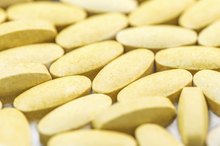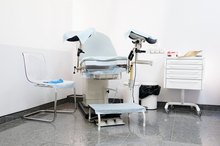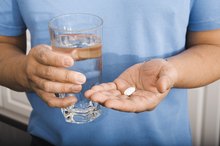What does fact checked mean?
At Healthfully, we strive to deliver objective content that is accurate and up-to-date. Our team periodically reviews articles in order to ensure content quality. The sources cited below consist of evidence from peer-reviewed journals, prominent medical organizations, academic associations, and government data.
- The Journal of Nutrition; Dietary Intake of Selected Nutrients Affects Bacterial Vaginosis in Women; Y. H. Neggers, et al.; September 2007
- The Journal of Nutrition; Dietary Intake of Selected Nutrients Affects Bacterial Vaginosis in Women; Y. H. Neggers, et al.; September 2007
- MedlinePlus; Lactobacillus; 3 June 2011
The information contained on this site is for informational purposes only, and should not be used as a substitute for the advice of a professional health care provider. Please check with the appropriate physician regarding health questions and concerns. Although we strive to deliver accurate and up-to-date information, no guarantee to that effect is made.
Acidophilus & Folic Acid for Bacterial Vaginosis
Bacterial vaginosis is a condition that combines an overgrowth of bacteria and a change of pH in the vagina. The primary symptom of this condition is a vaginal discharge, however, many women who have this condition do not notice any symptoms. While antibiotics are the most common treatment for vaginosis, folic acid and acidophilus supplements provide a milder and more alternative way to treat bacterial vaginosis.
If you are experiencing serious medical symptoms, seek emergency treatment immediately.
Causes of Bacterial Vaginosis
When a woman suffers bacterial vaginosis, there is a significant reduction in the number of normal hydrogen peroxide-producing lactobacilli and a significant increase in the number of anaerobic bacteria in the vagina. This can happen for many reasons. Usually an initial infection disturbs the vaginal balance and causes the overgrowth of pathogenic bacteria. Women under significant stress and psychological pressure experience changes in the vaginal pH, which leads to bacterial vaginosis often without any prior infection.
- When a woman suffers bacterial vaginosis, there is a significant reduction in the number of normal hydrogen peroxide-producing lactobacilli and a significant increase in the number of anaerobic bacteria in the vagina.
- Women under significant stress and psychological pressure experience changes in the vaginal pH, which leads to bacterial vaginosis often without any prior infection.
Acidophilus and Folate
Causes of Bacterial Vaginosis
Learn More
Lactobacillus acidophillus are naturally occurring beneficial bacteria in the vagina and gut. Folic acid is a water-soluble B vitamin that helps the body to make healthy new cells. It interacts with cellular DNA and supports healthy functions. MedlinePlus recommends between 1 to 2 billion CFU twice every day for up to six days for treating bacterial vaginosis. The recommended dose of folic acid for adult men and women is 400 mcg/day.
- Lactobacillus acidophillus are naturally occurring beneficial bacteria in the vagina and gut.
- MedlinePlus recommends between 1 to 2 billion CFU twice every day for up to six days for treating bacterial vaginosis.
Healing Action
A study published in "The Journal of Nutrition" suggests that the dietary intake of selected nutrients can affect the balance of bacteria in the vagina 1. In this study, folic acid intake was inversely associated with bacterial vaginosis. Folic acid supports the replication of acidophilus in the vagina and helps restore the balance of the bacterial flora. Acidofillus bacteria also produce lactic acid, which further corrects the pH of the vagina. Lactic acid has the ability to kill anaerobic bacteria and protects or treats vaginal infections. Acidophilus is available in the form of vaginal suppositories while folate is available in the form of pills that have to be taken orally.
- A study published in "The Journal of Nutrition" suggests that the dietary intake of selected nutrients can affect the balance of bacteria in the vagina 1.
- Folic acid supports the replication of acidophilus in the vagina and helps restore the balance of the bacterial flora.
Considerations
Vitamins That Help BV Infections
Learn More
Since acidophilus acid is a probiotic supplement consisting of live bacteria, it can potentially trigger an infection if you exceed the recommended dose. Folate acid is safe to take after a certain dosage, and no additional positive effects have been recorded. You should consult your physician before using acidophilus vaginal suppositories.
Related Articles
References
- The Journal of Nutrition; Dietary Intake of Selected Nutrients Affects Bacterial Vaginosis in Women; Y. H. Neggers, et al.; September 2007
- MedlinePlus; Lactobacillus; 3 June 2011
- Miller EA, Beasley DE, Dunn RR, Archie EA. Lactobacilli dominance and vaginal pH: why is the human vaginal microbiome unique?. Front Microbiol. 2016;7:1936. doi:10.3389/fmicb.2016.01936
- Lobo, RA, Gershenson, DM, Lentz, GM, Valea, FA. Comprehensive Gynecology. New York, NY: Elsevier Health Sciences; 2016.
- Heczko PB, Tomusiak A, Adamski P, et al. Supplementation of standard antibiotic therapy with oral probiotics for bacterial vaginosis and aerobic vaginitis: a randomised, double-blind, placebo-controlled trial. BMC Womens Health. 2015;15:115. doi:10.1186/s12905-015-0246-6
- De Alberti D, Russo R, Terruzzi F, Nobile V, Ouwehand AC. Lactobacilli vaginal colonisation after oral consumption of Respecta(®) complex: a randomised controlled pilot study. Arch Gynecol Obstet. 2015 Oct;292(4):861-7. doi:10.1007/s00404-015-3711-4.
- Murina F, Graziottin A, Vicariotto F, De Seta F. Can Lactobacillus fermentum LF10 and Lactobacillus acidophilus LA02 in a slow-release vaginal product be useful for prevention of recurrent vulvovaginal candidiasis?: A clinical study. J Clin Gastroenterol. 2014 Nov-Dec;48 Suppl 1:S102-5. doi:10.1097/MCG.0000000000000225.
- Vodstrcil LA, Walker SM, Hocking JS, Law M, Forcey DS, Fehler G, Bilardi JE, Chen MY, Fethers KA, Fairley CK, Bradshaw CS. Incident bacterial vaginosis (BV) in women who have sex with women is associated with behaviors that suggest sexual transmission of BV. Clin Infect Dis. 2015 Apr 1;60(7):1042-53. doi:10.1093/cid/ciu1130.
- Boskey ER, Cone RA, Whaley KJ, Moench TR. Origins of vaginal acidity: high D/L lactate ratio is consistent with bacteria being the primary source. Hum Reprod. 2001 Sep;16(9):1809-13.
- Boskey ER, Telsch KM, Whaley KJ, Moench TR, Cone RA. Acid production by vaginal flora in vitro is consistent with the rate and extent of vaginal acidification. Infect Immun. 1999 Oct;67(10):5170-5.
- Recine N, Palma E, Domenici L, Giorgini M, Imperiale L, Sassu C, Musella A, Marchetti C, Muzii L, Benedetti Panici P. Restoring vaginal microbiota: biological control of bacterial vaginosis. A prospective case-control study using Lactobacillus rhamnosus BMX 54 as adjuvant treatment against bacterial vaginosis. Arch Gynecol Obstet. 2015 Jul 5.
- Taha TE, Hoover DR, Dallabetta GA, Kumwenda NI, Mtimavalye LA, Yang LP, Liomba GN, Broadhead RL, Chiphangwi JD, Miotti PG. Bacterial vaginosis and disturbances of vaginal flora: association with increased acquisition of HIV. AIDS. 1998 Sep 10;12(13):1699-706.
Writer Bio
Francisco Javier Almeida Ponce has a master's degree in human molecular genetics from Imperial College London. He is an experienced writer and is mainly interested in science-related subjects and topics that promote quality of life. Ponce has been passionately writing about health, food and sustainable lifestyle for more than seven years.








